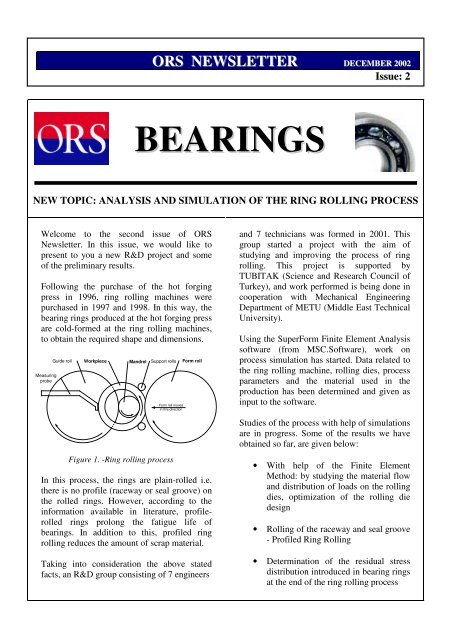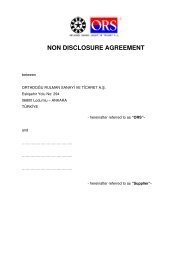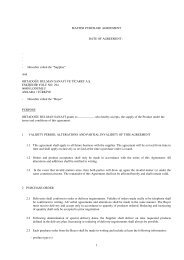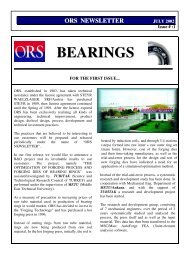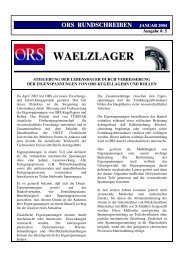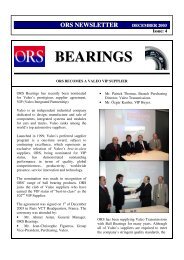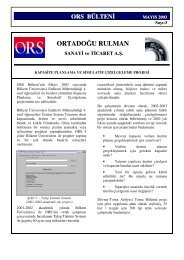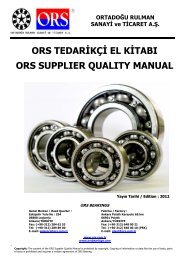Analysis and simulation of the ring rolling process - ORS Bearings
Analysis and simulation of the ring rolling process - ORS Bearings
Analysis and simulation of the ring rolling process - ORS Bearings
You also want an ePaper? Increase the reach of your titles
YUMPU automatically turns print PDFs into web optimized ePapers that Google loves.
<strong>ORS</strong> NEWSLETTER DECEMBER 2002<br />
Issue: 2<br />
BEARINGS<br />
NEW TOPIC: ANALYSIS AND SIMULATION OF THE RING ROLLING PROCESS<br />
Welcome to <strong>the</strong> second issue <strong>of</strong> <strong>ORS</strong><br />
Newsletter. In this issue, we would like to<br />
present to you a new R&D project <strong>and</strong> some<br />
<strong>of</strong> <strong>the</strong> preliminary results.<br />
Following <strong>the</strong> purchase <strong>of</strong> <strong>the</strong> hot forging<br />
press in 1996, <strong>ring</strong> <strong>rolling</strong> machines were<br />
purchased in 1997 <strong>and</strong> 1998. In this way, <strong>the</strong><br />
bea<strong>ring</strong> <strong>ring</strong>s produced at <strong>the</strong> hot forging press<br />
are cold-formed at <strong>the</strong> <strong>ring</strong> <strong>rolling</strong> machines,<br />
to obtain <strong>the</strong> required shape <strong>and</strong> dimensions.<br />
Measu<strong>ring</strong><br />
probe<br />
Guide roll<br />
Workpiece M<strong>and</strong>rel Support rolls<br />
Form roll moves<br />
in this direction<br />
Figure 1. -Ring <strong>rolling</strong> <strong>process</strong><br />
Form roll<br />
In this <strong>process</strong>, <strong>the</strong> <strong>ring</strong>s are plain-rolled i.e.<br />
<strong>the</strong>re is no pr<strong>of</strong>ile (raceway or seal groove) on<br />
<strong>the</strong> rolled <strong>ring</strong>s. However, according to <strong>the</strong><br />
information available in literature, pr<strong>of</strong>ilerolled<br />
<strong>ring</strong>s prolong <strong>the</strong> fatigue life <strong>of</strong><br />
bea<strong>ring</strong>s. In addition to this, pr<strong>of</strong>iled <strong>ring</strong><br />
<strong>rolling</strong> reduces <strong>the</strong> amount <strong>of</strong> scrap material.<br />
Taking into consideration <strong>the</strong> above stated<br />
facts, an R&D group consisting <strong>of</strong> 7 engineers<br />
<strong>and</strong> 7 technicians was formed in 2001. This<br />
group started a project with <strong>the</strong> aim <strong>of</strong><br />
studying <strong>and</strong> improving <strong>the</strong> <strong>process</strong> <strong>of</strong> <strong>ring</strong><br />
<strong>rolling</strong>. This project is supported by<br />
TUBITAK (Science <strong>and</strong> Research Council <strong>of</strong><br />
Turkey), <strong>and</strong> work performed is being done in<br />
cooperation with Mechanical Enginee<strong>ring</strong><br />
Department <strong>of</strong> METU (Middle East Technical<br />
University).<br />
Using <strong>the</strong> SuperForm Finite Element <strong>Analysis</strong><br />
s<strong>of</strong>tware (from MSC.S<strong>of</strong>tware), work on<br />
<strong>process</strong> <strong>simulation</strong> has started. Data related to<br />
<strong>the</strong> <strong>ring</strong> <strong>rolling</strong> machine, <strong>rolling</strong> dies, <strong>process</strong><br />
parameters <strong>and</strong> <strong>the</strong> material used in <strong>the</strong><br />
production has been determined <strong>and</strong> given as<br />
input to <strong>the</strong> s<strong>of</strong>tware.<br />
Studies <strong>of</strong> <strong>the</strong> <strong>process</strong> with help <strong>of</strong> <strong>simulation</strong>s<br />
are in progress. Some <strong>of</strong> <strong>the</strong> results we have<br />
obtained so far, are given below:<br />
• With help <strong>of</strong> <strong>the</strong> Finite Element<br />
Method: by studying <strong>the</strong> material flow<br />
<strong>and</strong> distribution <strong>of</strong> loads on <strong>the</strong> <strong>rolling</strong><br />
dies, optimization <strong>of</strong> <strong>the</strong> <strong>rolling</strong> die<br />
design<br />
• Rolling <strong>of</strong> <strong>the</strong> raceway <strong>and</strong> seal groove<br />
- Pr<strong>of</strong>iled Ring Rolling<br />
• Determination <strong>of</strong> <strong>the</strong> residual stress<br />
distribution introduced in bea<strong>ring</strong> <strong>ring</strong>s<br />
at <strong>the</strong> end <strong>of</strong> <strong>the</strong> <strong>ring</strong> <strong>rolling</strong> <strong>process</strong>
• Minimization <strong>of</strong> <strong>the</strong> <strong>process</strong> time <strong>and</strong><br />
accordingly, increase in <strong>the</strong> efficiency <strong>of</strong> <strong>the</strong><br />
<strong>process</strong><br />
• By <strong>rolling</strong> <strong>of</strong> <strong>the</strong> raceway <strong>and</strong> seal groove,<br />
decrease in <strong>the</strong> amount <strong>of</strong> scrap material, <strong>and</strong><br />
subsequently increase in <strong>the</strong> efficiency <strong>of</strong> <strong>the</strong><br />
following turning operations<br />
• Pr<strong>of</strong>iled <strong>ring</strong> <strong>rolling</strong>-bea<strong>ring</strong> fatigue life<br />
relation <strong>and</strong> study <strong>of</strong> its causes (in progress)<br />
• Testing <strong>of</strong> different materials <strong>and</strong> surface<br />
coatings for <strong>the</strong> <strong>ring</strong> <strong>rolling</strong> dies<br />
Figures shown below <strong>and</strong> on <strong>the</strong> right are<br />
some <strong>of</strong> <strong>the</strong> results <strong>of</strong> <strong>the</strong> <strong>simulation</strong>s done so<br />
far.<br />
Figure 2. - A sample FE analysis<br />
Figure 3. -Results obtained by 3-D analyses: total equivalent plastic strain formed in <strong>the</strong> <strong>ring</strong> cross-section (left)<br />
<strong>and</strong> load distribution on <strong>the</strong> <strong>rolling</strong> dies (right)<br />
<br />
<br />
<br />
! " <br />
# $ % &' () * + , )<br />
% &' () * + <br />
( % - . /<br />
<strong>ORS</strong> BEARINGS<br />
<br />
www.ors.com.tr<br />
www.orsbea<strong>ring</strong>s.com<br />
<br />
0 /1 ! 2 , <br />
* 0 /1<br />
! " <br />
# $ % &' () * + *<br />
% &' () * + * &0 3 4 +<br />
( % 5 /- . /


